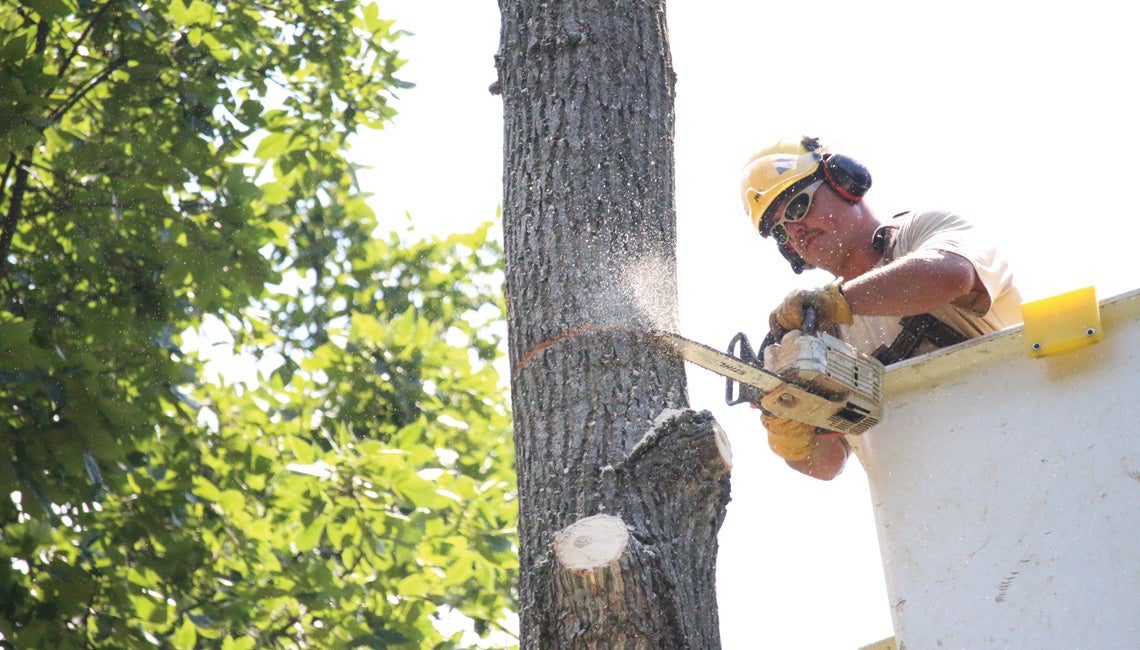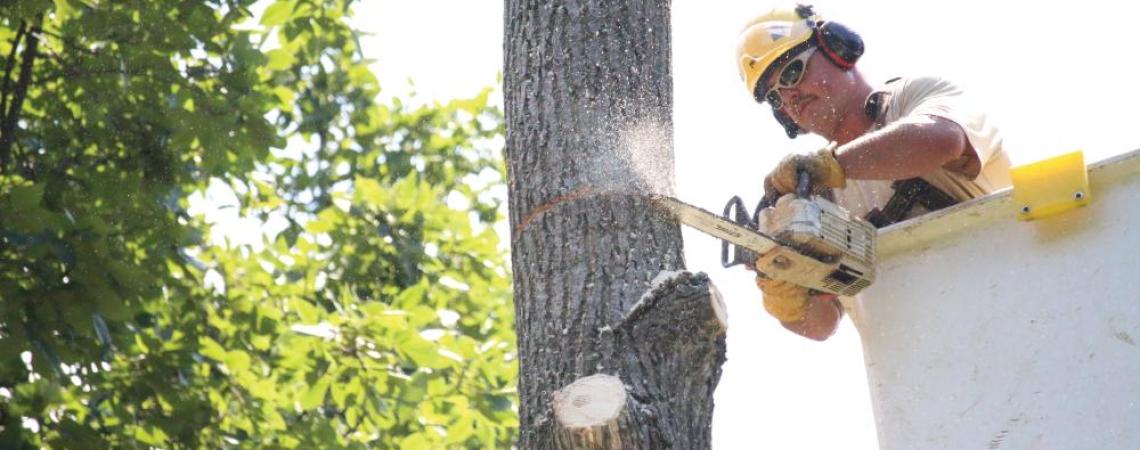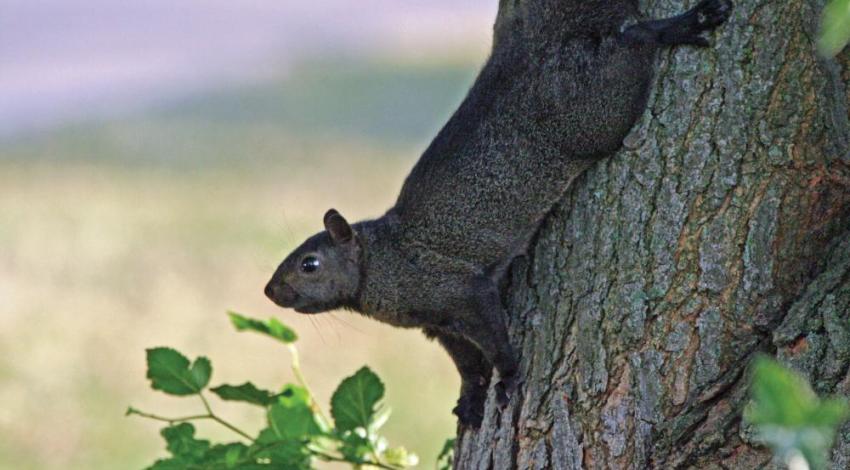In early March, a spring storm ravaged much of the region served by Logan County Electric Cooperative in Bellefontaine. It was the same storm that spurred the deadly tornado that destroyed a significant part of the community of Indian Lake, and even outside the tornado’s path, high winds snapped trees and brought down limbs and branches all around the area.
As might be expected, power outages were widespread. But upon examination in the following weeks, it seemed as if power had been out less for LCEC members — both fewer and shorter instances — than might have been expected.
Dan Craig, a certified line clearance arborist, is one of two full-time staff members at Logan County Electric Cooperative who are charged with the task of trimming trees and other vegetation away from the co-op’s power lines (Photo courtesy of Michael Wilson, Logan County Electric Cooperative Director of Communications).
“System reliability and safety are extremely important,” says Scott Roach, director of engineering services at LCEC. “With every new project, every work plan, it’s always with that in mind.”
Foliage foibles
One of the most significant factors affecting that reliability is the presence of trees. Of course, properly placed trees not only are beautiful to look at, but they also provide tangible benefits: increasing property values, reducing the cost to heat and cool a home, providing privacy, and even cutting stormwater runoff.
So homeowners are understandably attached to the trees that grow on their property, and Roach, who directs LCEC’s two-man full-time vegetation management crew that’s charged with keeping trees and other flora away from power lines, knows that co-op members can be quite protective of their foliage.
“We completely understand that trees hold a lot of sentimental value for our members,” Roach says. “At the same time, they need to understand the public safety issue and what impact a tree can have on their ability — and sometimes the ability of all of their neighbors — to turn their lights on.”
Trees can be a contributing factor, if not a direct cause, of as much as 50% of power outages. Problems can develop suddenly, such as when branches break and fall across power lines during wind or ice storms, or over time through natural growth patterns, where tree branches may begin to crowd and rub against those lines.
Investing in reliability
Logan County Electric has one of the best records of reliable power delivery in the country, but it wasn’t always that way. In 2005, a powerful winter storm came through Ohio, bringing with it layers of heavy ice that snapped off limbs and branches and brought down trees across the state.
Many of those branches and trees fell across electric power lines, and as many as 500,000 Ohioans were without power at one point — including a significant number of LCEC members. Some of those outages lasted 10 days or more.
“That storm taught us an important lesson, and we invested a lot of time and effort in our vegetation management right after that,” says Roach, who was hired in 2006. “We were not maintaining our right-of-way the way it should have been, but we made some changes in our procedures, and it has made a big difference in our outage numbers.”
Professional standards
Part of the co-op’s investment was to hire full-time vegetation management staff to implement a five-year trimming cycle, rather than bringing in contractors as needed.
“Tree trimming is a very difficult, labor-intensive job that’s also dangerous because obviously you’re working very close to energized lines,” Roach says, “But at the same time, there’s also an aspect of member service to it. If it’s rainy out and they have to put away the chain saws and chippers, they’re out talking to our members — informing them of what’s in the works and educating them about the public safety dangers of trees and power lines.”
In Ohio, along with LCEC, Adams Rural Electric Cooperative in West Union, The Energy Cooperative in Newark, and Frontier Power Company in Coshocton have full-time vegetation managers on staff. The other Ohio co-ops, for the most part, have long-standing relationships with professional tree contractors who perform the trimming around their lines.
All take great care to perform work that conforms to standards and practices of the National Arborist Association, the American Association of Nurserymen, and the Ohio Department of Natural Resources. The last thing anyone at the co-op wants is to fight with a member about a tree.
“Most people understand the reasons we need to trim their trees and don’t object to us doing what we need to do,” says Dan Craig, a certified line-clearance arborist, who has worked at Logan County Electric since 2015. “But it doesn’t always sit well with everyone, and we give members options and work with them to try to come up with a solution that works for both their needs and our needs.”
Of course, when a powerful storm comes through like the one in March, members are bluntly reminded the effect trees can have on utility lines. Says Roach, “After a storm that causes power outages, members see first-hand both the safety concerns and the importance of clearing vegetation away from power lines. No one likes to be without power.”
Trees and electricity
- The National Electrical Safety Code (NESC) requires electric utilities to maintain trees around power lines, pruning or removing vegetation that may damage supply conductors.
- The Occupational Safety and Hazards Act (OSHA), Rural Utilities Service (RUS) and the Federal Energy Regulatory Commission (FERC) mandate utility companies must keep their power lines safe and reliable.
- Trees account for more than half of all power interruptions.
- Tree damage to power lines can create severe public safety hazards such as fires or electrocution.
- Consider all electrical lines and electrical utility equipment dangerous. Keep away from them and keep all objects (ladders, antennas, kites, etc.) away from them.
- Keeping clear access to utility equipment gives line crews the room to perform inspections and repairs — and keeps everyone safe.










